
Montmartre is a large hill in Paris's northern 18th arrondissement. It is 130 m (430 ft) high and gives its name to the surrounding district, part of the Right Bank. Montmartre is primarily known for its artistic history, for the white-domed Basilica of the Sacré-Cœur on its summit, and as a nightclub district.

Lapin Agile is a famous Montmartre cabaret, at 22 Rue des Saules, 18th arrondissement of Paris, France.

The Basilica of Sacré Coeur de Montmartre, commonly known as Sacré-Cœur Basilica and often simply Sacré-Cœur, is a Catholic church and minor basilica in Paris dedicated to the Sacred Heart of Jesus. It was formally approved as a national historic monument by the National Commission of Patrimony and Architecture on December 8, 2022.

The 2nd arrondissement of Paris is one of the 20 arrondissements of the capital city of France. In spoken French, this arrondissement is colloquially referred to as deuxième. It is governed locally together with the 1st, 3rd and 4th arrondissement, with which it forms the 1st sector of Paris.

The 18th arrondissement of Paris is one of the 20 arrondissements, or administrative districts, of the capital city of France. In spoken French, this arrondissement is referred to as dix-huitième.
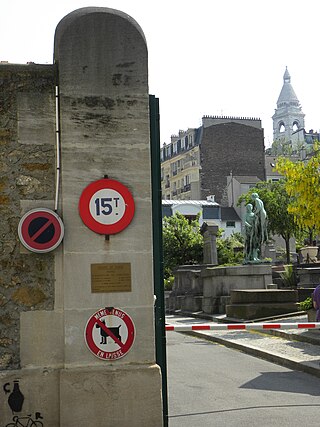
Saint-Vincent Cemetery is a cemetery in the 18th arrondissement of Paris.

Anvers is a station on Line 2 of the Paris Métro. It is located in Montmartre, on the border of the 9th and the 18th arrondissements.

François-Jean Lefebvre de la Barre was a French nobleman. He was tortured and beheaded before his body was burnt on a pyre along with Voltaire's Philosophical Dictionary nailed to his torso. La Barre is often said to have been executed for not saluting a Catholic religious procession, though other charges of a similar nature were laid against him.

Saint-Pierre de Montmartre is the second oldest surviving church in Paris, after the Abbey of Saint-Germain-des-Pres. It is one of the two main churches on Montmartre, the other being the more famous 19th-century Sacré-Cœur Basilica, just above it. Saint-Pierre de Montmartre, begun in 1133, was the church of the prestigious Montmartre Abbey, destroyed in the French Revolution.
Elaine Sciolino is an author and contributing writer of The New York Times, writing from France since 2002.

Hippolyte-Jules Lefèbvre was a French sculptor and medallist who received numerous official marks of recognition in his day but is now largely forgotten. His most prominent works are the monumental equestrian sculptures of Joan of Arc and Louis IX of France, set up on the Basilique du Sacré Cœur, Paris.

The Cirque Medrano is a French circus that was located at 63 Boulevard de Rochechouart, at the corner of rue des Martyrs, in the 18th arrondissement at the edge of Montmartre in Paris. It was originally called Cirque Fernando. The title "Cirque Medrano" is still active today: it is now a successful French traveling circus.
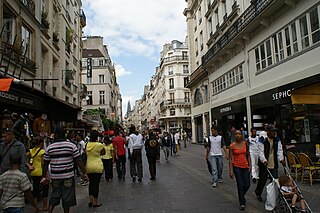
The Rue Saint-Denis is one of the oldest streets in Paris. Its route was first laid out in the 1st century by the Romans, and then extended to the north in the Middle Ages. From the Middle Ages to the present day, the street has been notorious as a place of prostitution. Its name derives from it being the historic route to Saint-Denis.
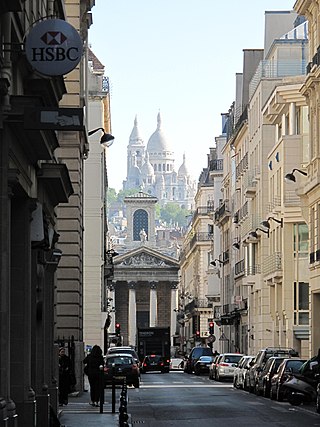
Rue Laffitte is a street in the 9th arrondissement of Paris, located near the Metro stations Richelieu - Drouot and Notre-Dame-de-Lorette.

The Rue d'Orsel is a street in the 18th arrondissement of Paris. It was previously known as the Rue des Acacias. It is in the neighborhood surrounding Montmartre, the butte (hill) where the Basilique du Sacré-Cœur is located.
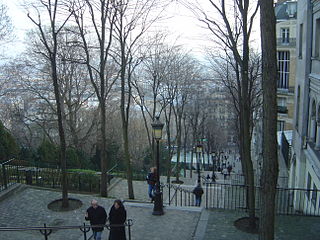
The Rue Foyatier is a street on the Montmartre butte ("outlier"), in the 18th arrondissement of Paris. Opened in 1867, it was given its current name in 1875, after the sculptor Denis Foyatier (1793–1863). One of the most famous streets in Paris, it consists of flights of stairs giving access to the top of the hill, the Sacré-Cœur Basilica, and the other attractions of the upper-Montmartre neighborhood. The Montmartre funicular runs alongside it.
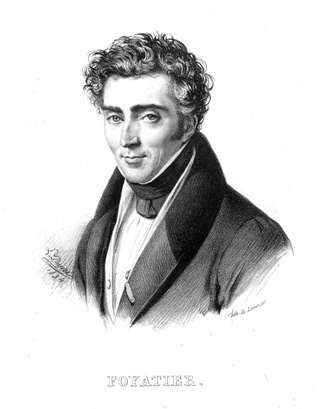
Denis Foyatier was a French sculptor in the neoclassical style.
This article presents the main landmarks in the city of Paris within administrative limits, divided by its 20 arrondissements. Landmarks located in the suburbs of Paris, outside of its administrative limits, while within the metropolitan area are not included in this article.

















